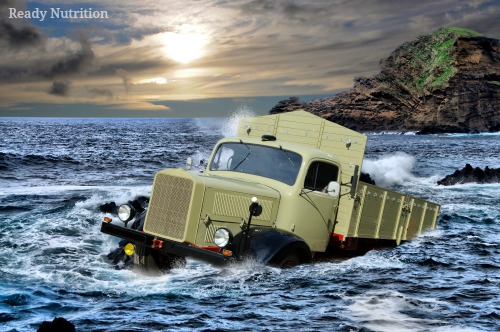
TRUMP SAYS: HUNTER MAKES FORTUNE FROM SHADY DEALS!
BIDEN FAMILY STINKS TO HIGH HEAVENS OF CORRUPTION!
DON'T GET LEFT OUT: HUNTER MUST BE STOPPED!

This article was originally published by Tess Pennington at Ready Nutrition
Tess is the author of The Prepper’s Blueprint: How To Survive ANY Disaster.

According to studies, over 10,000 water immersion auto accidents occur each year and over 300 people on average, perish before getting out. How many of you know what to do? Do you wait until the car has filled up with water so the car is pressurized and you can escape more easily? This is a common answer, but could get you killed. Many die because they have received the wrong information on how to escape a sinking vehicle. Breathing from a bubble of trapped air, kicking out a window or waiting until the car touched bottom all yields a less than 10 percent survival rate.
Here are the Facts:
Stay Calm: When an emergency arises and no plan is in place, things get tricky pretty fast. Stress or anxiety, especially after an unexpected event, leads to a short term imbalance of neurotransmitters, such as serotonin and norepinephrine, and inevitably leads to physical and emotional reactions to stress such as disorientation, increased breathing, panic and heart palpitations. Knowing how to curb these natural reactions can reduce the emotional and physical reactions.
Have a Plan: In a one minute period, a car will completely fill with water. Having a plan in place is the best way to improve your chances of survival and those with you. If the water is filling the car, quickly talk to your occupants and let them know what needs to happen. It is paramount that you keep as calm as possible because you have very little time to act. Survival Systems USA, has found that it takes about 20 seconds to escape through the door of a submerged car. A calm, relaxed person can hold their breath for 30 to 45 seconds underwater. So, if your pulse is pounding, you don’t have much room for error.
Make Your Escape: In many cases, a vehicle will actually float on top of the water for 30-120 seconds before sinking. Use this time to first undo your own seat belt and then, undo older children first so that they can help you with others or at least help themselves to safety. Once seat belts have been undone or cut, open the driver-side window and escape, first pushing children out ahead of you.
Do not wait until the car has completely filled with water. As well, do not open the door and try to escape. While you might be able to get out, the car will quickly fill with water and sink more rapidly, possibly trapping your passengers. Breaking a window is your best bet in making a quick exit. Because the windows are made of strong, tempered glass, it is important to have an accessible tool, like car safety hammer or the Tactical Auto Rescue tool, to easily cut through seat belt materials and break the window. If you have no tools or heavy objects to break the window with, use your feet.
Don’t waste precious seconds calling for help. Wait until you are safely out of the water before attempting to call 911.
In the following video, Dr. Gordon Giesbrecht, who specializes in cold water immersion has tested controlled sinking scenarios in vehicles using different strategies. “Bottom line, you have to remember four words, “Giesbrecht said. “Seatbelts. Windows. Children. Out.”
***
(Sign up for our FREE newsletter to get the latest prepping advice, gardening secrets, homesteading tips and more delivered straight to your inbox!)
Additional Resources:
The Prepper’s Blueprint: The Step-By-Step Guide To Help You Through Any Disaster
Prepper’s Home Defense: Security Strategies to Protect Your Family by Any Means Necessary
The Survival Medicine Handbook: A Guide for When Help is Not on the Way
SAS Survival Handbook, Revised Edition: For Any Climate, in Any Situation
Tess Pennington is the author of The Prepper’s Blueprint, a comprehensive guide that uses real-life scenarios to help you prepare for any disaster. Because a crisis rarely stops with a triggering event the aftermath can spiral, having the capacity to cripple our normal ways of life. The well-rounded, multi-layered approach outlined in the Blueprint helps you make sense of a wide array of preparedness concepts through easily digestible action items and supply lists.
Tess is also the author of the highly rated Prepper’s Cookbook, which helps you to create a plan for stocking, organizing and maintaining a proper emergency food supply and includes over 300 recipes for nutritious, delicious, life-saving meals.
Visit her web site at ReadyNutrition.com for an extensive compilation of free information on preparedness, homesteading, and healthy living.

It Took 22 Years to Get to This Point
Two domestic cats have died after drinking raw milk recalled for bird flu risk in California. A...
This article was originally published by Rhoda Wilson at The Exposé. We have all become familiar...
Conservative political commentator Tucker Carlson took part in a wide-ranging interview that was...
Commenting Policy:
Some comments on this web site are automatically moderated through our Spam protection systems. Please be patient if your comment isn’t immediately available. We’re not trying to censor you, the system just wants to make sure you’re not a robot posting random spam.
This website thrives because of its community. While we support lively debates and understand that people get excited, frustrated or angry at times, we ask that the conversation remain civil. Racism, to include any religious affiliation, will not be tolerated on this site, including the disparagement of people in the comments section.


Get out of it.
LMFAO… 10,000 incidences a year? I say Bullshit. Maybe 500. Post a link to that whopper if a claim. I was on Fire rescue for 7 years and never even heard of an incident. I say BS article again.
Ahhh its about selling some window breaking tool. Panic, quick, click the add link, buy buy buy.. BS!
The pattern that I am seeing is you criticizing every single article and author. Why don’t you submit an article? I mean clearly you think you’re enough of an expert to criticize the site every single day, criticize Mac every day, criticize every author, and every article. It’s consistent.
Meanwhile, there is nothing in your posts that demonstrates any proficiency…whatsoever. it’s weird. By now, I would have expected to come across some profound insight. Nope. They do not exist in your daily slams. Your posts are a big void of insight and mostly are bellyaching.
Maranatha, Because jackasses like you don’t even know what the term Nomad is or what they do. How about you shut the f*ck up, or do the research before you open your piehole with your long rambling nonsense rants like you even know something. You are a new comer here like a month or so. How about read and learn instead of talking out of your ass. I been on here since about 2010.
So what? Are you the self-appointed gate keeper???
I’ve been prepping since the midSeventies.
Grow up.
I was Right again, Another BS article to sell fear. 10,000 submerged cars my ass.
Here are the Facts: Strait from the National Highway Safety Traffic Administration White paper on Drowning deaths in motor vehicle traffic accidents.
ht tps://www.autosafety.org/sites/default/files/imce_staff_uploads/Drowning-Deaths-in-Motor-Vehicle-Traffic-Accidents.pdf
Overall Table 2 demonstrates that immersion is not a good predictor of whether the occupant fatalities involved drowning. Of the 332 vehicles with an immersion status of “yes” or “no” and a drowning death in the vehicle, immersion was included in the sequence of events only 61 percent (203/332) of the time. Among the 384 vehicles where immersion was recorded in the sequence of events including both vehicles with and without a drowning death, only 53 percent (203/384) had a known drowning fatality.
OK so less than 400 immersion vehicles a year and about 200 deaths from drowning. Who the F*ck makes up these BS articles anyway? Busted again.
Told ya it was a whopper. Exageration of 26 times the actual numbers of auto emmersions to create phony fear, to sell more usless BS Products.
The credibility factor of this site just dropped by 26% from this article. Wanna lie to your readers? Prepare for your literal beating. You are hereby ordered to receive 26 lashings in the public square!! So ordered here on Sept 15th 2018 the year of the lord.
Judge ~TharSheBlows
the broken window fallacy again. . .
Wow what a worthless fucking article.
If I’m driving through a flooded area perhaps I’ll drive without my seatbelt, and an open window.
The way we used to drive before Big Brother controlled us for our own good.
_
Where I live, ice fishing is a way of life. Every year several people go thru the ice in their cars; sometimes its the same people year after year. If driving on questionable ice, my best advice is to drive no faster than 10 mph and keep the window open. If you drive too fast you may actually go under the ice and the open window saves a lot of time. Fast speeds on ice cause a wave effect under the ice that can not be seen and the wave may cause an ice fracture.
Write your Congressman and demand legislation requiring automatic flotation devices on automobiles.
This is something that can’t be just ignored hoping it will go away on its own if we just bury our heads in the sand and pretend the problem isn’t there.
Think of the lives that can be saved, among them the little children that are helpless without our help to prevent their unnecessary deaths at the hands of greedy industrial magnates who simply don’t give a damn about anything but profits.
An ounce of prevention is worth a pound of cure. Never get in a car with a Democrat Senator.
Chappaquiddick.
Stay out of flood areas even if you think you can make it through. Every year during the monsoon, people go through or around signs warning of a flood area. Every year the fast water rescue crew has to drag their asses out.
You don’t have to live in a flood zone or be driving through one in a bad storm for this to happen. With our crumbling infrastructure, which includes *sudden water main breaks* flooding the area in a very short time just as you are driving through there, is inevitable and going to become more common.
Most of our underground systems are making it on borrowed time as it is. They are long overdue for upgrading. Currently, they get replaced one by one as they break — a reactive, not proactive approach. Another broken promise. President Trump promised new/upgraded infrastructure and so far that has not happened. Expect more water main breaks across the country, sudden flooding and loss of lives.
Great article, btw.
Always carry a razor sharp knife with you when driving so that you can cut the seat-belt off of you and escape the sinking vehicle.
I’m not a knife aficionado but own and use a couple of SOG Flash II knives that work very well for me. While this is a folding / assisted opening knife, I carry it in a small cell phone “holster” that attaches to my belt and is immediately available at need.
Always wondered how many 50 gallon drums it would take to float the average pickup loaded ,across the river? Anybody good at math?
What you asked is a common issue for river barges. Considering that you have perfect seals on the drums, then you would have to know how much they display ie the good old Archimedes principle (look up Eureka I found it! It’s a famous engineering story from ancient times).
Then you would have to describe how high the truck would sit from the water versus being partially submerged. Like a barge. If in the water, the truck’s tires and frame will affect how it steers through the river and it might not be possible to navigate …just merely floating. If even the slightest bit is in the water, then you have a crude but stiff rudder and since fixed, it may begin to spin slowly. Unless each barrel is perfectly symmetrical by size and position, your crude project is almost certainly unbalanced and will spin.
Not every watercraft is balanced. Take an outrigger canoe. Your question is very complicated. It sounds like a kooky idea.
Instead, why not look at the engineering for a FERRY. Then drive the vehicle on to a stable ferry that crosses via a steel cable and a motor?
I know that an empty gas tank acts as a float bag to lift the rear wheels of the ground , then no go. Any of you car guys know any tips to keep the electrical system going longer through water.?